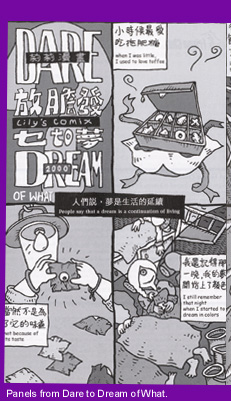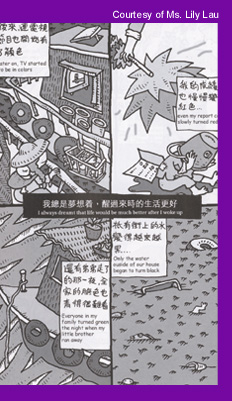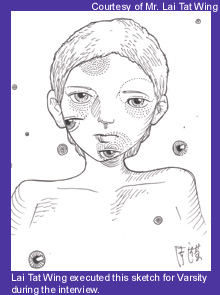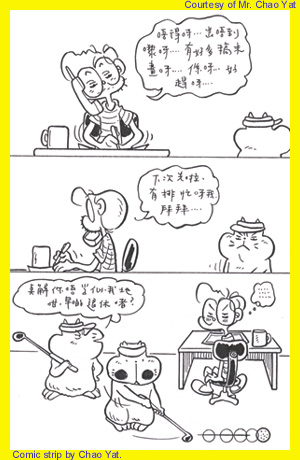
| Also featuring: | Local soundtrack production |
  |
Miss Lily Lau is a feminist and local comic artist who draws comics about gender, sex and politics.
Miss Lau said, “The themes of my comics are less covered in other comics.”
Miss Lau draws comics for a number of non-government organisations, newspapers and commercial magazines.
Most of her readers are women.
Her ideas come mainly from her experiences and her involvement in feminist activities.
“I always try to see things from a female point of view and a critical angle.
“I like to express my views about the world and also my dissatisfaction with society through my comics,” said Miss Lau.
Mr. Lai Tat Wing is another local comic artist. He joined the field 5 years ago.
“I hope that teenagers will observe more, think more, after reading my comics.
“In fact, there is no specific topic that I would like to talk about when I am drawing my comics,” said Mr. Lai.
Mr. Lai said that there might be no answers or ideas at the ends of his stories.
“I would like to leave the questions to my readers, especially secondary and university students,” said he.
Mr. Lai has developed a unique style in his comics.
The characters usually have no fixed style, status or even name.
Said he: “I always try not to mould my characters to a standard form since I want to leave some room for my readers to think.”
He said that there are no specific topics he likes to talk about.
“When I have to draw, I open books or dictionaries and take out unrelated things randomly.
“I then link them up into a story,” said Mr. Lai.
Mr. Chao Yat is another comic artist. He draws comics for Ming Pao and Oriental Daily.
Simple, lively figures, including trees and animals, are his media of expression.
 “If
the readers cannot understand the comics, they will not be attracted
to read them,” said Mr. Yat.
“If
the readers cannot understand the comics, they will not be attracted
to read them,” said Mr. Yat.
Mr. Yat said this is how a close relationship between the artist and readers is cultivated.
Despite the small market for alternative comics, comic artists of various kinds have emerged in recent years.
“The main reason is that there are some successful examples which encourage more new artists,” said Mr. Chan Man Kee, a comics fan.
The biggest difficulty for alternative comic artists is how to develop an inspirating story line.
Mr. Chan said, “Reading comics is just an entertainment for most comic readers.
“Most readers read comics for relaxation. They will not spend much time on brooding over the underlying meaning.”
Mr. Chan said readers prefer to choose mainstream comics which are exciting and less intellectual.
To overcome this difficulty, Mr. Yat said that comic artists have to decide between the artists’ and the readers’ interests.
Mr. Yat has chosen the latter.
Some criticised that alternative comics are unpopular because they are harder to digest.
“Since most of the alternative comic artists expect readers to think, most of their readers are from the middle class,” said Mr. Chan.
However, Miss Lau did not agree with this.
“Please do not underestimate the ability of readers.
“The ability to understand a story does not depend on the class or education level of readers,” said Miss Lau.
She said that their abilities are not related to how wealthy the readers are.
Miss Lau said that the key is whether the stories touched readers’ hearts.
She explained that if readers have experiences and feelings about society, then they must have their unique way to interpret comics.
She claimed that readers do not have to contemplate the stories.
She said that what the readers get out of her comics does not have to match her original ideas.
She thought that everyone should have their own point of view.
“I am not drawing comics for anybody, I just want to treat comics as a tool of reflection.
“And what readers think is their own choice,” said she.
However, sometimes, the artists may need to change their drawing style in order to meet market demands.
“Sometimes, we may need to use different drawing styles to attract people
“However, this doesn’t mean that we will change our principles,” said Mr. Lai.
Besides the receptiveness of the content on the part of readers, the cultural background of Hong Kong is another problem.
 Both
Mr. Yat and Miss Lau agreed that the colonial background of Hong Kong
was a big obstacle for people to build up their own culture.
Both
Mr. Yat and Miss Lau agreed that the colonial background of Hong Kong
was a big obstacle for people to build up their own culture.
“Actually, I believe that people can accept a great diversity of cultures.
“However, the problem is that they do not know what their own culture is,” said Mr. Yat.
Mr. Yat said that even artists raised in a mixed culture do not have a cultural identity.
“Therefore, it is quite hard for readers to be aware of their own culture and to pay for local alternative comics,” said Mr. Yat.
Miss Lau agreed.
She said people would not have any idea how to develop their own culture unless the political situation was more stable and the status of citizens was clearer.
Mr. Joe Tsui is the store manager of the East Bank Bookshop.
Mr. Tsui regards the lack of promotion and channels as other obstables in expanding the market for alternative comics.
“Compared with mainstream comics, there are very few advertisements and little news related to alternative comics,” said Mr. Tsui.
He said that only a small number of people know what alternative comics are.
“Besides, those comics are sold at very few places, and people rarely happen to see them,” said he.
Although alternative comics barely survive, their evolution will not stop.
Mr. Tsui said that people would know more about alternative comics as long as there are activities and promotions.
He said, “More activities such as forums with artists as speakers will be held in the future.
“More reporting about artists would also help increase public awareness,” he said.
Artists also have their own views towards the development of local comics.
“We cannot control the market, but we can try our best to draw the best comics we can,” said Mr. Yat.
“Artists have to support each other and strive for room to survive,” said Miss Lau.
Miss Lau hopes that more support will be forthcoming from society.
She said, “I hope that art development policies in Hong Kong can be further developed to promote local comics, say, by providing more resources and training for artists.”
It is not surprising that the three local comic artists have a common hope to have a more diverse market.
“I hope that more artists will draw different topics of comics,” said Mr. Yat.
Mr. Yat agreed that there should be more choices for readers.
Miss Lau said, “One day, when our comics become the mainstream, it will indicate a higher degree of receptivity.”
“At the same time, I will try to discover new things.”
For the development of alternative comics, people have to wait and
see.![]()